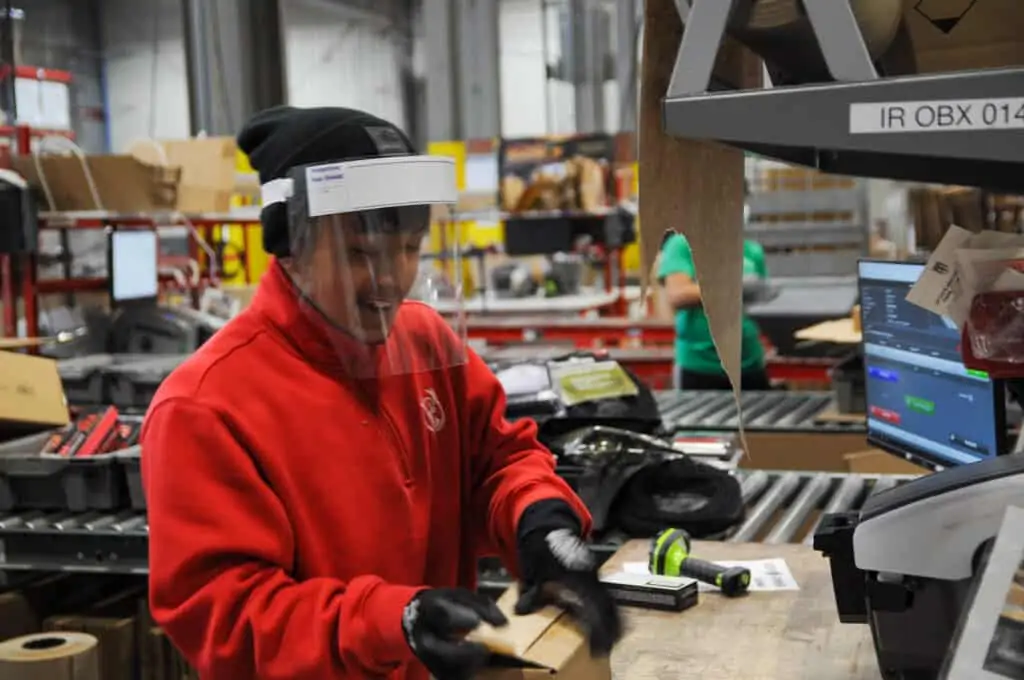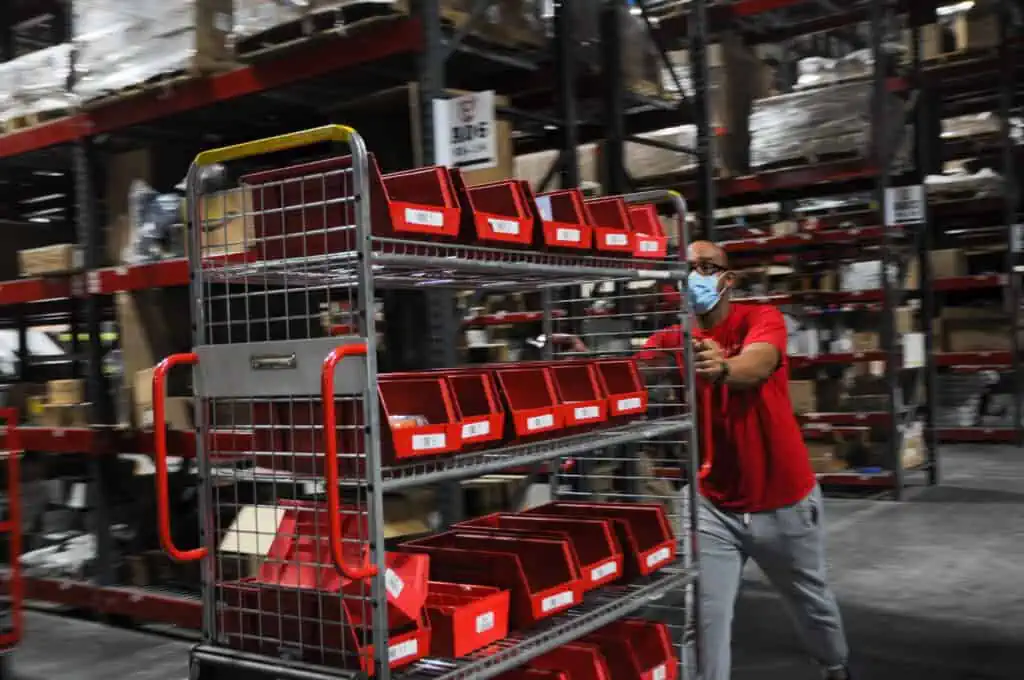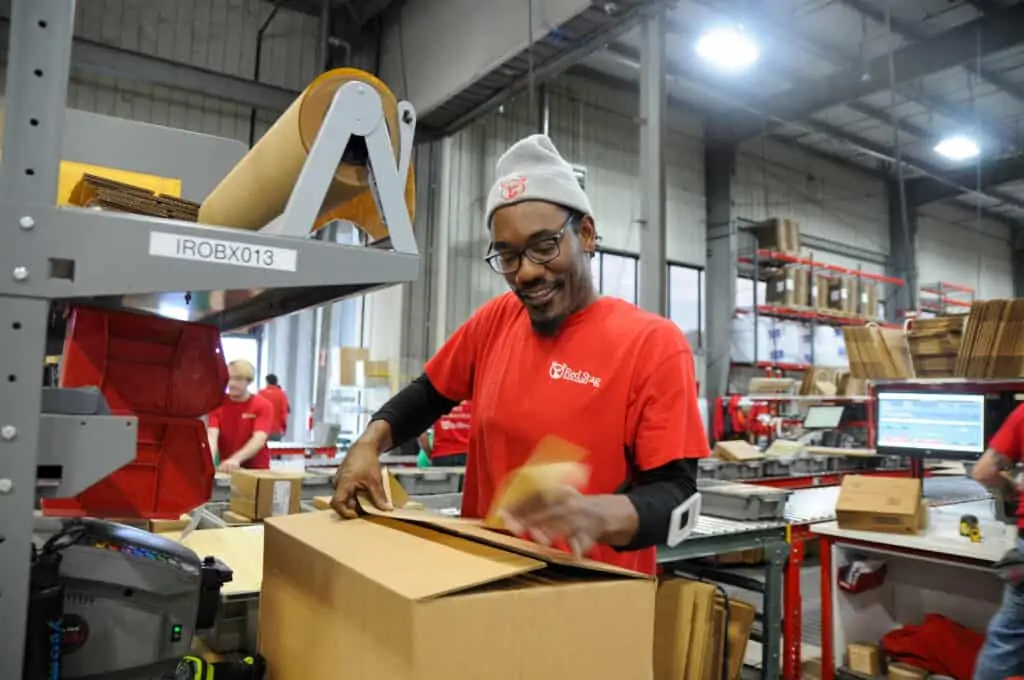Ecommerce shoppers have the same high expectations for every online store, no matter what size, so small business owners must leverage every tool available to compete with bigger businesses. Nowhere is that truer than in ecommerce fulfillment.
While setting up and managing complex logistics systems requires massive resources, you don’t have to manage the process on your own. By leveraging tested strategies and resources, you can create an excellent small business order fulfillment process that will grow your brand and make your customers happy.
Here’s your complete guide to outstanding order fulfillment for small businesses. If you are interested in potentially outsourcing this process, here is a list of the best 3PLs for small business.
TL;DR:
Small business order fulfillment essentials

Focus on speed, accuracy, and cost-effective shipping to build trust with customers.

Choose from four fulfillment methods: self-fulfillment, drop shipping, FBA, or 3PL services.

Optimize warehouse layout, use WMS software, and implement quality control checks to improve accuracy.

Save on shipping by optimizing packaging, consolidating shipments, and leveraging 3PL shipping discounts.
Small business order fulfillment principles
To create an order fulfillment operation that will wow your customers and keep them ordering from your online store, start with these vital principles of ecommerce fulfillment.

Speed matters
01
Online shoppers want their orders delivered quickly. You can increase the speed of order delivery by optimizing inventory management to avoid stockouts, improving picking methods, and managing fulfillment locations.
Accuracy is critical
02
It doesn’t matter how fast the order arrives if it’s the wrong size, color, or quantity. Shopping is a fun experience for consumers, but returning a mis-picked order is a hassle. Improving picking and packing accuracy is one of the best ways to boost customer satisfaction.
Low-cost shipping makes everyone happy
03
Free delivery is a highly-prized perk for consumers, but you can’t afford to offer it unless you keep your shipping costs low. And, if the customer pays for shipping, keeping the price reasonable will help drive sales.
Fulfillment is all about trust
04
Consumers are more likely to trust your brand and become loyal shoppers when your fulfillment is fast, accurate, and reasonably priced. To build consumer trust, you need a fulfillment company you can trust to deliver the outstanding fulfillment services your customers expect.
4 methods of small business order fulfillment
There are several different ways to manage your fulfillment. The best method for your business depends on your operation’s size, preferred sales channels, and growth trajectory. Most ecommerce businesses use different fulfillment methods at different times, and many use multiple fulfillment channels simultaneously.

Self-fulfillment
01
Many ecommerce entrepreneurs start by storing inventory in their own warehouses and managing order fulfillment in-house. For micro businesses and bootstrapped startups, self-fulfillment is the logical choice. Inventory management is likely minimal, and you might pack and ship orders yourself in the beginning.
Starting with self-fulfillment gives you the advantage of a thorough knowledge of the pick and pack process. You may develop strategies for creating delightful unboxing experiences that set your brand apart, and you can continue them even after you grow to the point where you need to outsource fulfillment.
PRO TIP: Handling small business order fulfillment in-house with a small warehouse and one or two staff responsible for order handling can quickly get overwhelming. To maintain the excellent customer experience you need to grow your brand, consider outsourcing when your order volume begins to strain your resources.

Drop shipping
02
Drop shipping is another fulfillment strategy often adopted by small business startups. In the dropshipping business model, you find products to sell and list them in your online store, but you only buy merchandise after a customer makes a purchase. The drop shipping supplier holds the inventory and sends orders directly to your customers.
Dropshipping is an excellent option for small business owners who don’t want to get involved in inventory management or order fulfillment. However, you have less control over the process, making it harder to build a thriving ecommerce company.
NOTE: There might be a long lag between when your customer places an order and when they receive it due to fulfillment delays at your drop shipper, distance from the drop shipping warehouse to the customer, or backordered products. With little insight into the delays, you may not be able to communicate with your customer, leading to poor customer satisfaction and retention.
Drop shipping is a practical small business order fulfillment strategy for entrepreneurs with limited capital or people who don’t want to deal with ecommerce logistics. It can allow you to start with a broader product range but expect thinner profit margins on your sales.

Fulfillment by Amazon
03
Whether you have a custom ecommerce site or sell on a platform like Shopify, you’ll probably want to list products in the Amazon marketplace. Amazon sales account for more than a third of online purchases, so it’s a critical place to connect with your market.
If you sell on Amazon, you may be able to use Amazon’s vast logistics network for your order fulfillment. Fulfillment by Amazon, or FBA, can give you access to Prime’s fast shipping and bump your products in search results. However, you must meet Amazon’s sales velocity criteria to qualify for FBA, and the service doesn’t usually accept oversized or bulky products. Amazon also limits stock near the holidays because of limited warehouse capacity, so FBA could throttle your peak sales volume.
Key Takeaway: If your business qualifies for FBA, it can be an excellent way to offer speedy fulfillment for products you sell on Amazon and other online marketplaces without the need to manage logistics. Just be aware of the drawbacks before you choose Amazon as your fulfillment partner.

Third-party logistics
04
A third-party logistics company, or 3PL, specializes in ecommerce warehousing and fulfillment. Every 3PL has different criteria and specializations; some work only with clients meeting a minimum monthly order volume. However, many 3PLs provide small business order fulfillment without order minimums, including crowdfunding fulfillment companies and warehouses specializing in meeting the fulfillment needs of companies that sell in online marketplaces such as eBay. Outsourcing your order fulfillment can be an excellent way to free your time to work on other aspects of your business and to help your company grow and scale.
The advantages of working with a fulfillment company include the following:

Fulfillment professionals pick and pack your orders; you don’t need to hire, train, or manage staff.

You pay only for the warehouse space you need and can flex up or down as demand changes. That keeps your storage fees low and gives you the flexibility to expand quickly when needed.

A fulfillment company will have daily, scheduled pickups with the major carriers, so your packages ship right away.

You can choose a fulfillment provider with warehouses appropriately sited to reach your customers quickly, saving time and money on shipping.

As a volume shipper, your 3PL may be able to offer shipping discounts and flexible carrier selection you couldn’t access on your own.

Many fulfillment providers also handle returns processing.
Key Takeaway: The key to an excellent 3rd party logistics experience is to pick the right fulfillment company for your business. Choose a provider with expertise in products like yours and top ratings for speed and accuracy.

Steps in the ecommerce fulfillment process
No matter which small business order fulfillment solution you choose, the process involves these basic steps.
01
An order is transmitted to the warehouse and placed in the picking queue
The order fulfillment process starts when a customer makes a purchase. Data flows from the shopping carts on your ecommerce platforms to your fulfillment warehouse instantly (or at least it should). Software integrations between your online store and the warehouse management software make this seamless. The warehouse puts the order into a queue for picking and packing.
02
The picker gathers items to fill the order
Warehouse management software generates a pick list for each order, which is a list of items needed to fill the order. The pick list includes other information, such as the quantity of each item and the numbered shelf location where the picker can find each SKU.
Depending on the size and layout of the warehouse, you can use different picking methods. For instance, if you only get a few orders a day, you might pick them one at a time as they arrive. In a sizeable 3PL warehouse, pickers might use zone or wave picking and gather items for several orders at once to minimize travel time and keep the process moving quickly.
03
The packer boxes the order and labels it for shipping
After the picker pulls the SKUs for the order, often putting them into a bar-coded bin, they drop them at the packing station. In a well-run warehouse, the packer double-checks the pick list to ensure that the correct SKUs for the order go into the box. They select the correct box for each order (big enough to hold all the items without much extra room for shifting) and fill gaps in the box with infill. The final step at the packing station is affixing the shipping label.
04
A carrier picks up the package and delivers it to the customer
After the packer closes the box, it goes to the shipping station. There, packages are sorted by carrier and, in most cases, picked up the same day.

5 ways small businesses can improve order processing
There are hundreds of adjustments, both large and small, that you can make to improve your order fulfillment. Here are five impactful changes to boost your logistics operations.
Prepare your warehouse for your typical orders
01
Using past sales and fulfillment data, analyze the weight and size of your typical order. That will help you stock sturdy boxes in the correct dimensions to ship your orders. If you work with a 3PL, this information allows them to serve you better.
Upgrade your inventory management
02
Inventory planning is essential for enhancing your cash flow, but it also improves small business order fulfillment. By analyzing your sales history and forecasting future sales, you can optimize your supply chain, so you’re prepared to meet demand.
Create a system of checks to prevent fulfillment errors
03
To ensure accurate fulfillment, check and recheck this order. The process doesn’t have to be time-consuming — you can use bar codes and scanners to quickly check that the pick list SKU matches the SKU on the shelf or in the box. Reducing fulfillment errors also saves you money on returns processing.
Use warehouse management software to optimize picking
04
Warehouse management software (WMS) can help with layout to optimize picking routes. It can also generate pick lists for different picking methods to increase your order fulfillment speed. And a WMS can improve accuracy, requiring a correct scan of each SKU before allowing the picker to move on to the next item. Your 3PL will likely use a sophisticated WMS to streamline pick and pack fulfillment.
Work with a 3PL that specializes in products like yours
05
If you outsource your fulfillment, choose a 3PL that knows how to pack and ship products similar to yours. A warehouse filled with apparel isn’t a good fit for fulfilling delicate glass vases and vice versa.

Tips for saving money on small business order fulfillment
Fulfillment, particularly shipping, is a significant expense, and controlling fulfillment costs is essential to your profitability. Here are four tips to help your small business save money on order fulfillment.
Optimize box size and weight to reduce surcharges
USPS, UPS, and FedEx assess surcharges for packages over specific size and weight limits. In addition, large boxes may be subject to dimensional weight pricing.
These charges can significantly add to the shipping cost. However, you may be able to avoid or reduce them through smart packaging choices. In some cases, shipping a heavy order in multiple boxes may be cheaper than putting everything in a single, heavy parcel.
Calculate shipping charges per product and order and use software to help you make the right shipping choice every time.
Package consolidation
When shipping some products, such as bicycles, you can’t avoid dimensional weight charges. However, you can save when you ship DIM weight packages with package consolidation.
For example, suppose a customer orders a bicycle plus several small accessories (lights, panniers, helmet). In that case, you can consolidate the smaller items into the bike box. They’ll ship together for no additional charge.
Ship from central warehouse locations
When you use a warehouse in one of the corners of the country (such as Florida or Southern California), you not only increase the delivery time for distant customers, you increase shipping costs. Choose a 3PL with one or more centrally located fulfillment centers, and you’ll save money on shipping for every order.
Leverage shipping discounts through your 3PL
At Red Stag Fulfillment, we’re a high-volume shipper. We’ve negotiated favorable shipping rates from the major shipping services and share those discounts with our clients. Because we’re one of the top 3PLs for heavy and bulky products, we’ve even negotiated favorable DIM factors to reduce dimensional weight charges.

Small business order fulfillment made simple
Great order fulfillment is essential to the success of your small business. And being small doesn’t mean you can’t afford top-notch order fulfillment services.
At Red Stag Fulfillment, we’re more than a warehouse. We see ourselves as a strategic growth partner for our clients, and we’ve watched many of them grow exponentially with the help of our industry-leading accuracy and speed. Our strategic warehouse locations provide two-day shipping to 96% of U.S. addresses. And we make it easy to switch fulfillment companies with a dedicated onboarding team to ease your transition.








